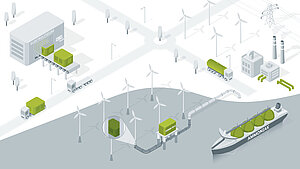The appropriate transport infrastructure forms the backbone of a future hydrogen economy. However, it still needs to be clarified which transport solutions are most suitable for covering short, medium and long distances. Where can existing gas networks be converted? Which completely new transport technologies are needed? What obstacles need to be removed? The lead project TransHyDE aims to advance hydrogen transport technologies in five accompanying research and four demonstration projects. It will be funded by the Federal Ministry of Education and Research (BMBF) with around 139 million euros over the next four years.
"Our goal is to answer all the questions that Germany still has to ask itself in order to build a national hydrogen infrastructure," explain the three coordinators of TransHyDE, Mario Ragwitz from Fraunhofer IEG, Robert Schlögl from the Max Planck Institute for Chemical Energy Conversion and Jimmie Langham from the AquaVentus coordination office. "As one of the key measures of the Federal Ministry of Education and Research for the implementation of the National Hydrogen Strategy, we have to answer these questions in a scientifically and technically robust way so that the foundations for the real execution of the hydrogen turnaround are laid."
The lead project TransHyDE evaluates and tests hydrogen transport solutions. It is advancing transport technologies in four demonstration projects: hydrogen transport in high-pressure containers, hydrogen-liquid transport, hydrogen transport in existing and new gas pipelines, and the transport of hydrogen bound in ammonia or the carrier medium LOHC.
In addition, the lead project is dedicated to hydrogen transport in five scientific projects, thus creating the systemic framework. These deal with the creation of a roadmap for the hydrogen infrastructure, the development of possible standards, norms and safety regulations for hydrogen transport technologies as well as the necessary materials and sensors. In addition, the scientific TransHyDE projects deal with the efficient separation of hydrogen from ammonia and the refuelling of containers with liquid, cryogenic hydrogen.
Currently, about 85 partners from industry, associations, universities and research institutions as well as 20 associated partners have joined forces in the lead project TransHyDE. TransHyDE is to receive funding of around 139 million euros from the BMBF. Most of the work in the TransHyDE projects started on 01.04.21.
Partner: ca. 85 (plus 20 assoziierte Partner) | Fördersumme: ca. 139 Millionen | Projektlaufzeit: 01.04.2021-31.03.2025
More about the project: https://www.wasserstoff-leitprojekte.de/leitprojekte/transhyde
Part of a demonstration project is the AmmoRef joint project, in which the MPI CEC is also involved, in particular the working group of Dr. Saskia Heumann.
Detailed information on the AmmoRef project can be found here.
About the hydrogen lead projects:
The hydrogen lead projects are the largest research initiative of the Federal Ministry of Education and Research (BMBF) on the topic of energy transition to date. In the industry-led lead projects, industry and science are jointly developing solutions for the German hydrogen economy: series production of large-scale electrolysers (H2Giga), production of green hydrogen at sea (H2Mare), technologies for the transport of hydrogen (TransHyDE).
The hydrogen lead projects are the result of an ideas competition: science, industry and civil society were invited to submit ideas for large-scale hydrogen projects. More than 240 partners have come together in this way and are to be funded with a total of about 740 million euros. In spring, the projects were launched on the basis of non-binding funding prospects. The lead projects will be funded over a period of four years. Further information is available on https://www.wasserstoff-leitprojekte.de.

